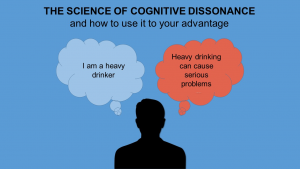Introduction
For this assignment ENGL 301 students must choose a complex term from the student’s discipline or profession and provide 3 definitions: a parenthetical definition, a sentence definition and an expanded definition. The objective of this assignment is to understand the importance of definitions and to understand the different levels of detail between each definion in order to determine which definition is most appropriate to use given the situation.
Based on the criteria and objectives, the concept of “Cognitive Dissonance” will be explained by a psychology student. The audience is composed of fellow university students from various disciplines, therefore I expect some audience members to possess only basic knowledge of this concept.
Parenthetical Definition:
Cognitive dissonance (mental conflict due to inconsistent thoughts, beliefs or attitudes) causes feelings of unease and discomfort.
Sentence Definition:
Cognitive dissonance is a psychological conflict whereby one’s existing thoughts, beliefs or attitudes are challenged by contradictory information, resulting in mental discomfort (Britannica, 2021).
Expanded Definition
What is Cognitive Dissonance?
Cognitive dissonance is mental conflict which arise due to beliefs and actions being challenged by contradictory information. People tend to strive to maintain consistency in their beliefs and perception. The inconsistency between what one believes and how they actually behave causes discomfort (Cherry, 2020).

(https://alcoholstudies.rutgers.edu/changing-minds-to-save-them/)
What is its history?
Leon Festinger was came up with the cognitive dissonance theory in 1957. Festinger studied committed cult members who went as far as to give up their homes and jobs to join the cult inorder to be saved from a flood that was predicted to destroy the earth. When this flood eventually did not occur, the more committed the members were, the more unwilling they were to hold on to their beliefs about the flood, despite being proven wrong. Instead of coming to terms with their wrongful predictions, committed members attempted to protect their beliefs by attributing the absense of the earth destroying flood to their faithfulness to the cult (McLeod, 2018).
Festinger explained that people do this because cognitive dissonance causes unease and discomfort. On the other hand, alignment across our beliefs, attitudes and behaviour promotes mental harmony. Therefore, humans seek to maintain this harmony in order to escape the stress of mental dissonance (McLeod, 2018).
Today, despite its criticisms, the concept of cognitive dissonance is considered one of the most pivotal theories in social psychology (Harmon-Jones & Mills, 2019).
What causes it?
Cognitive dissonance may occur due to forced compliance, where an individual is required by external forces to behave or act in a certain way that is inconsistent to the individual’s own beliefs. Additionally, dissonance may result from decision making. If an individual must choose only one option when the alternatives are equally desirable, then that individual may be faced with dissonance in deciding which option to choose, because both have advantages and disadvantages the other does not have. Lastly, learning new information that contrasts the information believed and accpeted by an individual may cause dissonance as well (Cherry, 2020).
What is needed to resolve it?
People experiencing cognitive dissonance will attempt to reduce it. As is with the case of the cult members in Festinger’s study, one method is to protect ones beliefs by seeking out more support for that belief. Likewise, individuals experiencing cognitive dissonance may attempt to rationalize their beliefs or actions when faced with conflicting information. One may justify that the impact of the contradicting beliefs or actions are insignificant. On the other hand, individuals may deal with cognitive dissonance by changing their beliefs and actions to. Despite being this being the most effective method, people often do not choose this method because it is difficult for people to change deeply held beliefs. Sometimes, like with the cult members who gave up their homes and jobs for the cult, changing ones beliefs and values means coming to terms with the unpleasant reality (Cherry, 2020).
Works Cited
Britannica, T. Editors of Encyclopaedia (2019, April 5). Cognitive dissonance. Encyclopedia Britannica. https://www.britannica.com/science/cognitive-dissonance
Cherry, K. (2020, July 02). What is Cognitive Dissonance? Verywell Mind. https://www.verywellmind.com/what-is-cognitive-dissonance-2795012
Harmon-Jones, E., & Mills, J. (2019). An introduction to cognitive dissonance theory and perspectives on the theory. In E. Harmon-Jones (Ed.), Cognitive dissonance: Reexamining a pivotal theory in psychology (pp. 3-24). American Psychological Association. https://doi.org/10.1037/0000135-001
Leod, S. (2018, February 05). Cognitive Dissonance. Simply Psychology. https://www.simplypsychology.org/cognitive-dissonance.html.
Leave a Reply